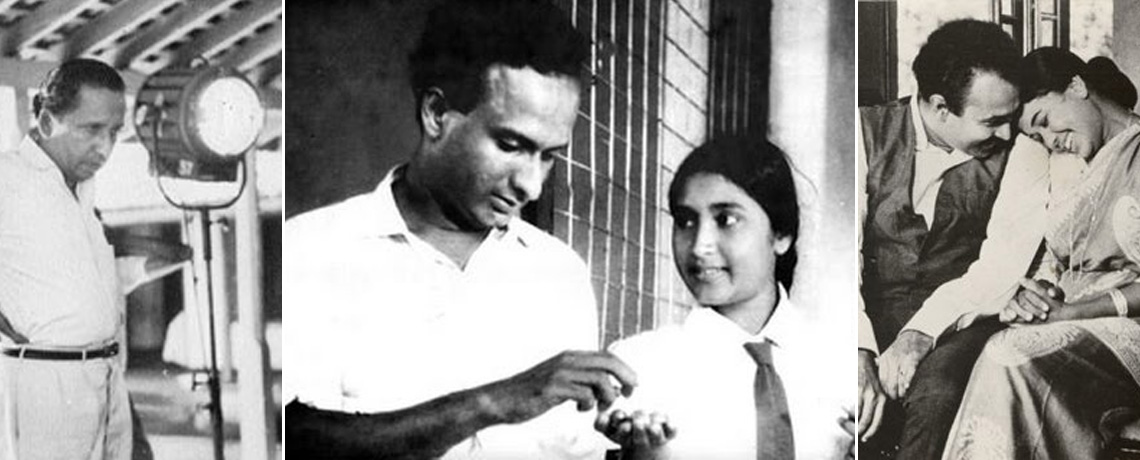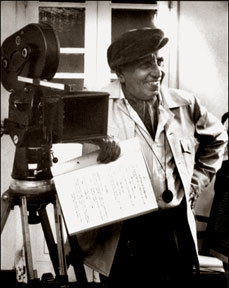28 Jul 2017 - {{hitsCtrl.values.hits}}

“In handling a camera I feel that I have no peer. But what De Sica can do, I can’t do. I ran his Shoeshine again recently and the camera disappeared, the screen disappeared; it was just life...” ~ (Orson Welles)
 One Friday night, not too long ago, I switched on the TV for no reason whatsoever. I went on pressing the remote until I came across a channel which telecast Sinhala movies every week. This time around, they were screening something that had been shown 15 years ago, which they (wrongly) thought was being shown for the first time on local television. I was 10 when I saw it last, but even at that age it left such an impression on me that I could remember almost every shot and how it would end.
One Friday night, not too long ago, I switched on the TV for no reason whatsoever. I went on pressing the remote until I came across a channel which telecast Sinhala movies every week. This time around, they were screening something that had been shown 15 years ago, which they (wrongly) thought was being shown for the first time on local television. I was 10 when I saw it last, but even at that age it left such an impression on me that I could remember almost every shot and how it would end.
They started screening it at 10.30. At about 11.30 I read a message from a young man inviting me to watch and review an event organised by a society at his school the following week at the Lionel Wendt. I was more interested in what was being screened, so I texted him excitedly, “Tune into XYZ TV, there’s a lovely Sinhala film on.” Feeling rather perturbed at my own haste (because who sends messages like that to young people anymore?), however, I added, “Count me in for next week’s show!” By then the story had entered its second half, emotionally the most difficult to wade through. I laid aside the phone for about five minutes, and then took it back.
This young man had messaged me. Expressing delight at the fact that I would come to and write on his Society’s event, he replied to my earlier missive: “I am not into Sinhala films. Don’t get them.” Numbed, I asked, “What about Sinhala novels?” He fired back: “Not really. I’m not that fluent in Sinhalese.”
The reply, and the conversation that preceded it, almost deadened me.
I watched the remainder of the story, well past midnight, remembering what was to come and how it was to end. I had wept at it before. I wept at it again.
As the credits rolled and Amaradeva’s music soared so high, my spirits couldn’t keep up, I remembered that young man and his casual dismissal of our movies, and I wept harder. It seemed as though sorrow had kissed me that night: I cried all the way to my dreams, tears streaming on to my pillow, and woke up the following morning, still sobbing.
When people say they don’t “get” Sinhala movies, they aren’t thinking of how fluent or inarticulate they are in their mother tongue. Rather, they are thinking about their incapacity to digest a particular type of film in narrative terms. The young have given up on our cinema, because the best in our cinema escape them. They see the worst and think that the best are no different to the worst.
No. They’re put off because they can’t digest the possibility that our cinema can breed good stories, the same kind of stories they get from Lucas, Spielberg, and Bay.
Our movie industry was birthed by a set of people who didn’t know how to make movies. They were storytellers and mythmakers at best, who had earlier lived off the theatre. From the theatrical thrust of the Jayamanne brothers to the idealism of Lester James Peries to the anti-idealism of Dharmasena Pathiraja to the independent cinema of Prasanna Vithanage, Asoka Handagama, and Vimukthi Jayasundera, consequently, the divide between what was arty and what was commercial remained. So much so that today, the likes of that young man only get to see the latter. Not the former. And even if they do see the former, they will see what they dislike there too.
The truth then is that our mainstream directors don’t know how to tell a story anymore. Even the kitschiest moviemakers from the past – Robin Tampoe, K. A. W. Perera, Neil Rupasinghe, Daya Wimalaweera, and Yasapalitha Nanayakkara– knew how to transform the unreality of the experience in their work to the emotions and gestures they got from their audiences. At one level this was class bound; the same middle class that cried at Janaka saha Manju when it was first released laugh at it now, while the lower classes continue to weep over its contrived plot.
 A well read neighbour of mine shocked me the other day by swearing (as though it were the gospel truth) that Janaka saha Manju was the saddest love story he’d ever seen.
A well read neighbour of mine shocked me the other day by swearing (as though it were the gospel truth) that Janaka saha Manju was the saddest love story he’d ever seen.
That other young man, by contrast, was involved with his school’s English Literary Society, debates in English, and comes from a conservative upper middle class background. If we are to extract a metaphor from this, the prince disparages even the best of ours, while the pauper fawns on what’s taken by the prince as the worst.
I have unfortunately been writing about the best and the worst and the pedestrian without assigning any value to them. For me, and I daresay for most discerning youngsters today, the best movies are those that don’t compel analysis, that seem so well oiled that no interpretation is necessary. The middle-class youngsters of today, for instance, know that Michael Bay is not “great”, just as they know that Wes Anderson is “greater” in aesthetic terms. But they are pulled more by narrative power than by aesthetics, which explains that at times inexplicable box-office dividends reaped by Armageddon, Pearl Harbour, and the Transformers franchise.
 The best works of Lester James Peries – Gamperaliya, Golu Hadawatha, and Akkara Paha – told a story aimed at enthralling a common denominator. These were movies that breathed naturally, without the aid of technique. Lester’s most intellectual work Delovak Athara, on the other hand, was made for academic study, while Nidhanaya occupied a twilight world between Edgar Allan Poe and Freud’s couch (as I implied in last week’s article). By contrast, Golu Hadawatha and Akkara Paha – the first and second in a trilogy that Lester made for Ceylon Theatres – are so vividly realised that all they do is fascinate us. Like what De Sica’s Shoeshine was to Orson Welles, in them the camera and the screen disappear; what comes out is life itself.
The best works of Lester James Peries – Gamperaliya, Golu Hadawatha, and Akkara Paha – told a story aimed at enthralling a common denominator. These were movies that breathed naturally, without the aid of technique. Lester’s most intellectual work Delovak Athara, on the other hand, was made for academic study, while Nidhanaya occupied a twilight world between Edgar Allan Poe and Freud’s couch (as I implied in last week’s article). By contrast, Golu Hadawatha and Akkara Paha – the first and second in a trilogy that Lester made for Ceylon Theatres – are so vividly realised that all they do is fascinate us. Like what De Sica’s Shoeshine was to Orson Welles, in them the camera and the screen disappear; what comes out is life itself.
That movie I watched after 15 years, which got me to understand the existential dread felt by our young men towards our cinema, ranks alongside the best on that count. Sagara Jalaya Madi Handuva Oba Sanda remains the true masterpiece of Lester’s wife, Sumitra.
When people say they don’t “get” Sinhala movies, they aren’t thinking of how fluent or inarticulate they are in their mother tongue
It also remains an almost perfectly conceived movie, a point which escaped that young man because he equated every movie made here with the comedies of Roy de Silva (which even I don’t get).
Sumitra’s movie suggests the beauty and poignancy of living, in a world far removed from ours (it’s set in the North Central Province, near the Wanni). It points out that a work of art, allowed to breathe naturally, can become timeless. How can one not get it?

The young men of this country aren’t put off by Sinhala movies because they aren’t conversant in Sinhala. If that were the case, I wouldn’t be writing this, because my fluency in the mother tongue is pedestrian at best, definitely more pedestrian than that of the young man I talked with. No. They’re put off because they can’t digest the possibility that our cinema can breed good stories, the same kind of stories they get from Lucas, Spielberg, and Bay. And because they can’t digest, they refuse to watch.
I don’t think they are to blame, frankly. The fact is that we were once moved by stories. Stories in the cinema. When our movies lost their narrative touch, when directors began to hanker after awards and agencies and everything else paraded in the name of Art, they lost touch with you and me, the common cinemagoer. When that happens, inevitably, we lose our interest in our industry. And when we, the common cinemagoers, lose interest, the best our industry can do is to survive on those same awards and agencies and High Artiness that we repudiated. In effect, getting into Sinhala movies has become hard, difficult, at times even impossible.
23 Nov 2024 4 hours ago
23 Nov 2024 5 hours ago
23 Nov 2024 6 hours ago
23 Nov 2024 7 hours ago
23 Nov 2024 23 Nov 2024